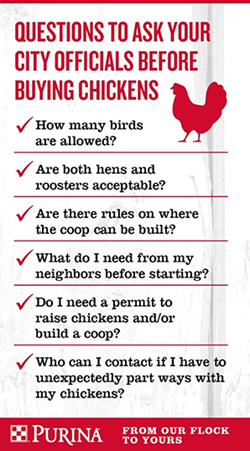
Can I Raise Backyard Chickens in My Area?
Starting a Flock : Considering Chickens
Starting a Flock : Environment
Once you’ve made the decision to raise backyard chickens, nothing can squash your enthusiasm for ordering cute baby chicks and researching cool backyard chicken coops! Well, nothing except your local chicken ordinance… You need “chicken permission” before you start counting your fresh eggs. Find out who to talk to, what questions to ask and the steps to take to ensure you can have a backyard chicken coop where you live.
We’re seeing an explosion of backyard chicken coops in both urban and rural areas. The Purina flock family spans from coast-to-coast with smaller urban chicken coops, spacious backyard suburban coops and sprawling country coops.
If you’re considering joining the backyard chicken movement for self-sufficiency, first find out if you have chicken permission. Many townships, villages and cities have embraced the benefits of backyard flocks; however, chicken keeping is not yet permitted everywhere.
2. Find out what regulations govern backyard poultry raising in your municipality.
Some cities have rules about the size of your flock, coop building or amount of acreage needed per animal. Others allow hens to be raised within city limits, but not roosters. Before buying your birds, make sure you understand all the rules.
Consider asking these questions:
3. Secure a copy of the local chicken ordinance.
To be certain your new feathered friends can stay in your family, secure a copy of the local chicken ordinance and keep it on file. It’s also handy to have if neighbors have questions or concerns.
4. If backyard chickens are not allowed, empower change.
If your local government does not zone for backyard chicken coops, do something about it! Change is possible by amending local laws. Depending on your area, you may need to fill out paperwork and attend a local government meeting.
In this case, the best bet is preparation. Join forces with other flock enthusiasts and urban chicken raisers to outline the benefits of raising birds and a plan for backyard chicken coops. Oftentimes, showing community support and the benefits are key drivers to add chickens to a community.
Many urban communities have a local meetup or chat groups dedicated to raising backyard chickens. You can find one in your area with a simple online search.
5. Visit with your neighbors.
Once you have “chicken permission” and the go-ahead to start, visit your neighbors and share your plans with them.
It’s always best to share plans in advance and to work together on the project. Describe the benefits, quiet nature and community opportunities of raising chickens. And above all, invite them over for a coop-warming party to meet your ladies!
6. Design a backyard chicken coop ideal for you and your area’s conditions.
Now your family can begin one of the most exciting parts of the process: planning your flock and designing your backyard chicken coop.
There are hundreds of breeds to choose from. Determine if you wish to have chickens for eggs, meat or show. Explore the breeds’ personalities, amount of space they need and if they are right for your climate. Then, pick up supplies and start small with a flock of four to six chicks. Your local Purina retailer is a good resource to help you get started.
Thinking about getting your first chicks? Visit our Baby Chick Resource Center for everything you need to start chicks strong.
We’re seeing an explosion of backyard chicken coops in both urban and rural areas. The Purina flock family spans from coast-to-coast with smaller urban chicken coops, spacious backyard suburban coops and sprawling country coops.
If you’re considering joining the backyard chicken movement for self-sufficiency, first find out if you have chicken permission. Many townships, villages and cities have embraced the benefits of backyard flocks; however, chicken keeping is not yet permitted everywhere.
To determine if backyard chicken coops are permitted in your area, follow these steps:
1. Ask local officials if backyard chicken coops are permitted. 
2. Find out what regulations govern backyard poultry raising in your municipality.
Some cities have rules about the size of your flock, coop building or amount of acreage needed per animal. Others allow hens to be raised within city limits, but not roosters. Before buying your birds, make sure you understand all the rules.
Consider asking these questions:
- How many birds are allowed?
- Are both hens and roosters acceptable?
- Are there rules on where the coop can be built?
- What do I need from my neighbors before starting?
- Do I need a permit to raise chickens and/or build a backyard chicken coop?
- Does my subdivision or homeowner’s association (HOA) permit chickens?
- Who can I contact if I must unexpectedly part ways with my chickens?
3. Secure a copy of the local chicken ordinance.
To be certain your new feathered friends can stay in your family, secure a copy of the local chicken ordinance and keep it on file. It’s also handy to have if neighbors have questions or concerns.
4. If backyard chickens are not allowed, empower change.
If your local government does not zone for backyard chicken coops, do something about it! Change is possible by amending local laws. Depending on your area, you may need to fill out paperwork and attend a local government meeting.
In this case, the best bet is preparation. Join forces with other flock enthusiasts and urban chicken raisers to outline the benefits of raising birds and a plan for backyard chicken coops. Oftentimes, showing community support and the benefits are key drivers to add chickens to a community.
Many urban communities have a local meetup or chat groups dedicated to raising backyard chickens. You can find one in your area with a simple online search.
5. Visit with your neighbors.
Once you have “chicken permission” and the go-ahead to start, visit your neighbors and share your plans with them.
It’s always best to share plans in advance and to work together on the project. Describe the benefits, quiet nature and community opportunities of raising chickens. And above all, invite them over for a coop-warming party to meet your ladies!
6. Design a backyard chicken coop ideal for you and your area’s conditions.
Now your family can begin one of the most exciting parts of the process: planning your flock and designing your backyard chicken coop.
There are hundreds of breeds to choose from. Determine if you wish to have chickens for eggs, meat or show. Explore the breeds’ personalities, amount of space they need and if they are right for your climate. Then, pick up supplies and start small with a flock of four to six chicks. Your local Purina retailer is a good resource to help you get started.
Thinking about getting your first chicks? Visit our Baby Chick Resource Center for everything you need to start chicks strong.





